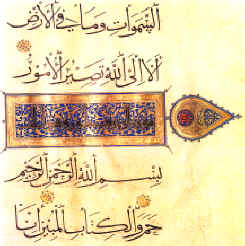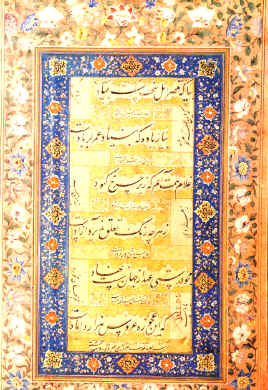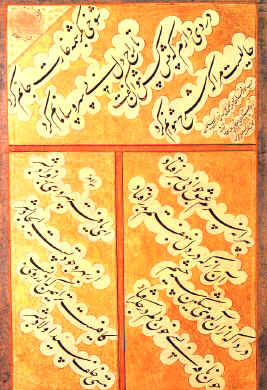The Art of Calligraphy
"Ancient Iranians with an alphabet of 36 letters, used skins and pen to write,
Instead of ear-then tablets"; W. Durant
The art of calligraphy is one of the reputable and famous arts in Iran.
The glorious art of calligraphy and its numerous decorations have always been praised by Iranologs.
The importance of the art of calligraphy among Iranian arts is such, that some arts seem to be imperfect, without decorative calligraphy.
Iranians more than any other nation have used various calligraphy to enrich and beautify earthen-ware, metallic vessels and historic buildings.
Most of the handwritten books of Iran specially the Holy Quran, and collections of poems such as Shahnameh, Hafez, Golestan, Boostan and Khayam have been recognized as precious artistic works because of their graceful and delicate calligraphy.
These books possess extraordinary value and importance for the art experts all around the world.
The calligraphy works of notorious and virtuous calligraphers of Iran are preserved as precious artistic works in museums and private collections all around the world.
The art of calligraphy in Iran has a long history. This history includes the opposition of writing in Iran and its process of evolution from the ancient times till the Islamic period and from this period till the present time.
A tablet in Hierogliff writing discovered in the north-western part of the Iranian plateau, belonging to the pre-historical period is a sign that the early inhabitants of Iran possessed inscriptive signs and methods. In archaeological searches of Silak and Marlik, dishes and cylindrical seals engraved with the very first Iranian writings have been discovered. M. Diacono, the Russian orientalist has called these documents:
The holy writings and believes that they belong to the end of the 4th and the beginning of the 3rd millennium BC.
 |
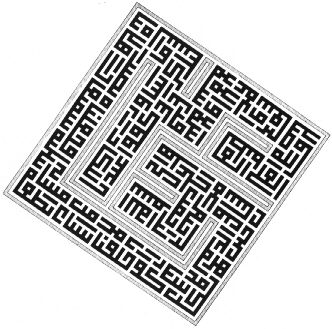 |
Hertzfan, believes that the Marlik inscriptions on cylindrical seals belong to the 5th millennium BC. A precious collection of Iranian inscriptions is preserved in the "Hermitage" museum of Lenin-grade. The cuneiform writing was invented by Iranians and honored later by Sumerians.
In the 7th century BC, Medes for the first time in history invented a kind of alphabet consisting of 36 letters.
W. Durant has stated in his writings that Iranians with an alphabet of 36 letters used skins and pen to write, instead of earthen tablets.
The numerous tablets available in Bisotoon, Passargad and Persepolis display the symbols used by old Iranians for writing.
Handwritten manuscripts of Avesta the religious book of the ancient Iranians, were written with gold on skin.
Tablets with cuneiform, Avesta and Pahlavi, writings discovered in Iran, have been deciphered by the world's great linguistic experts and their contents are published.
These tablets are made of half-burned clay, bricks, stones, skin and golden and silver sheets.
Some of these tablets are considered as samples of the art of calligraphy in the ancient Iran.
After the domination of Islam, the present Iranian alphabet was created.
The Kufic writing was the very first inscription used for decorating earthenware and metallic dishes after the reign of Islam in Iran.
The most ancient sample of the flowered cuneiform writing exists in a tablet installed in the mosque of Nain and belongs to the end of the 3rd Islamic century. In this tablet, the beginning and the end of each letter is adorned with paintings resembling leaves from a date-tree.
In the Islamic period, Iranian artists put to work in various ways the Arabic alphabet to adorn mosques and holy constructions, wooden doors, earthenware and metallic vessels.
The art of calligraphy flourished even more when the Holy Quran, Shahnameh, and other books were written and reached the highest degree of perfection during the next centuries.
During the Safavid era, virtuous Iranian calligraphers, invented all diverse forms of the Persian writing.
Thousands of tablets, books and attractive handwritten pieces are available among the artistic works of calligraphy in Iran.
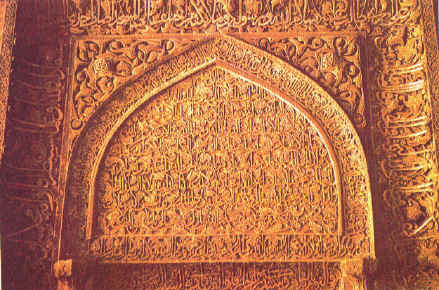
|
 |
|
|
These works show that Iranian artists are almost unparalleled in the world in creating beauty through their writings.
After the flourishing period of the art of calligraphy, the precious calligraphic books required special care and preservation. Therefore the production of beautiful leather bindings for these magnificent books appeared as a new art.
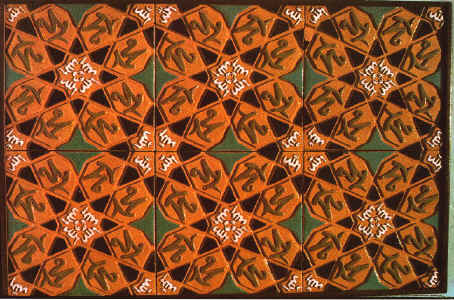
Iranians acquired great success in the art of binding books in various ways. The leather cover of these books were enriched in the most gracious manner by geometrical and floral patterns and various landscapes.
The art of illumination has had a great role in decorating these leather covers. Some of the most valuable handwritten books of Iran, with leather bindings are being kept in the "Metropolitan" museum, the "National Library of Paris", the "Library of Munich" and some private collections. The calligraphy in these books is mostly accomplished by the great masters of this art.
Writing is considered a tool for the comprehension of the contexts all over the world, but in Iran writing has made its way of becoming an estimable art.
Although art experts around the world are not much informed about the contents of the Persian handwriting, they tend to use Iranian calligraphy work to adorn their libraries and private collections. The expertise brought forth in Iranian calligraphy expresses the most gracious artistic notions.

